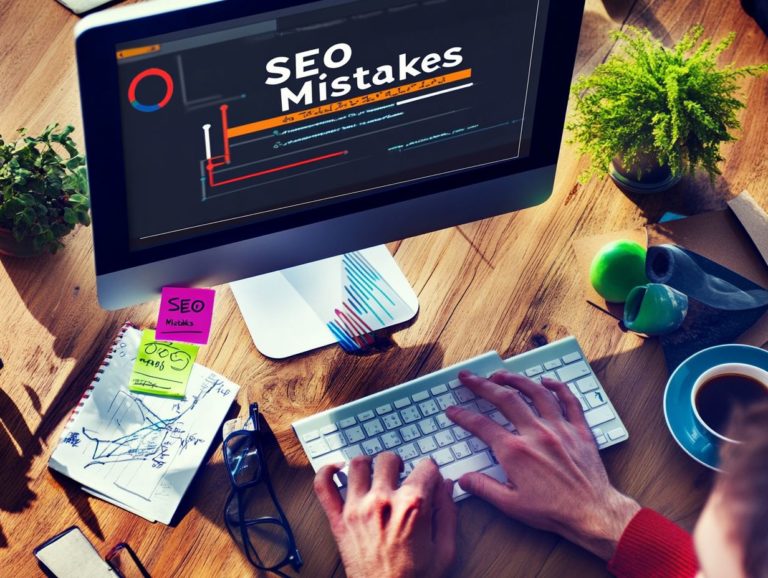The Importance of Speed for Website Traffic
In today s digital landscape, website traffic is essential for success. However, the critical importance of speed in attracting that traffic is often underestimated.
Fast-loading websites enhance user experience and elevate search engine rankings, increasing their visibility to potential visitors. This article delves into the essence of website traffic, emphasizes the necessity of speed, and provides insights on how to measure and enhance your site s performance.
The article also covers all the strategies you need to keep your visitors engaged and eager to return for more.
Contents
Key Takeaways:

- A fast website is crucial for attracting and retaining visitors.
- Measuring speed helps identify improvement areas with various available tools.
- Optimizing images, using caching, and selecting reliable hosting boosts speed.
Understanding Website Traffic
Website traffic means the number of people visiting your site. It directly impacts key performance indicators like conversion rates, user engagement, and overall revenue.
By analyzing web traffic data, you can uncover user behavior patterns, optimize your site for peak performance, and enhance the user experience. This approach helps you meet user expectations and improves your Google rankings through more effective strategies tailored to search intent.
What is Website Traffic?
Website traffic includes the number of visitors and interactions your site receives, originating from diverse types and sources such as organic, direct, referral, and social traffic.
Understanding these distinctions is vital for refining your digital marketing strategies. Organic traffic comes from search engines when users enter relevant queries, while direct traffic typically emerges from individuals who type your website s URL directly into their browsers. Referral traffic springs from links on other sites, highlighting the importance of partnerships and backlinks. Social traffic, derived from social media platforms, shows your potential to connect with broader audiences.
To assess the effectiveness of these traffic sources, closely monitor key metrics like unique visitors, page views, and session duration. These insights illuminate user engagement and the overall performance of your website.
Why Speed Matters for Website Traffic
Website speed is a pivotal element that profoundly shapes user experience, directly affecting both bounce rates and conversion rates. A quickly loading website meets the high expectations of users and optimizes overall site performance an essential strategy for any online business aiming to maintain a competitive edge in today s digital arena.
As users become more impatient, even a mere one-second delay in page load speed can lead to significant drops in traffic and revenue. Therefore, prioritizing speed is an essential consideration in your website development and design strategy.
Impact on User Experience
The impact of website speed on user experience is critical. Slow loading times can lead to frustration, causing users to abandon your site and affecting your conversion rates.
Research shows that users expect a website to load in under three seconds. In fact, studies reveal that even a one-second delay can reduce user satisfaction by 16%. This focus on speed is underscored by Core Web Vitals, which prioritize loading performance, interactivity, and visual stability.
Websites that meet these performance benchmarks excel at retaining users, significantly lowering bounce rates. For example, a prominent online retailer experienced a remarkable 20% increase in conversions after optimizing their site speed, showcasing the compelling benefits of enhancing user experience through faster loading times.
Effect on Search Engine Ranking

Website speed is an essential SEO factor that significantly influences your Google rankings. Search engines favor fast-loading pages in their algorithms.
A website’s loading time dramatically affects user experience, leading to higher bounce rates when pages take too long to load. Metrics like Time to First Byte (TTFB) and Fully Loaded Time are crucial for assessing performance. They empower you to gauge how quickly your content is accessible to visitors.
Google has made it clear that slower sites may suffer a negative impact on their rankings, particularly on mobile devices, where speed is increasingly vital. Therefore, integrating effective SEO strategies that prioritize site speed optimization is not just beneficial; it s imperative for enhancing your visibility in search results.
How to Measure Website Speed
Measuring website speed is essential for grasping performance metrics and enhancing user experience. You have access to various testing tools designed to provide accurate assessments of your site’s load times and overall speed.
These insights allow you to optimize your website effectively, ensuring it operates at its best for your users.
Tools for Testing Website Speed
Tools like GTmetrix and WebPageTest are critical for conducting speed tests. They enable you to analyze load times and identify areas ripe for improvement.
Both tools deliver comprehensive metrics, including page size, requests, and the total time to fully load all crucial for gauging your site’s overall performance. They generate detailed analysis reports that pinpoint specific elements causing delays, allowing you to prioritize your optimizations effectively.
By regularly utilizing these testing instruments, you not only maintain optimal website speed but also enhance the user experience. This ensures that your visitors can access content quickly. Consistent monitoring and analysis are essential for spotting potential bottlenecks and making necessary adjustments, ultimately leading to improved search engine rankings and greater visitor satisfaction.
Improving Website Speed
To elevate your website’s speed, employ a blend of optimization techniques. This includes:
- Fine-tuning images
- Optimizing code
- Implementing effective caching strategies
- Leveraging content delivery networks (CDNs)
These strategies significantly enhance overall performance.
Optimizing Images and Code
Optimizing images and code is essential for enhancing your website’s speed. Large files and inefficient code can significantly slow down loading times, diminishing user engagement.
Here are some effective strategies you can use:
- Employ image compression techniques to reduce file sizes without compromising quality. Tools like TinyPNG or ImageOptim can be invaluable.
- Consider using modern image formats like WebP to further boost performance.
- Minification, which means reducing the size of your code by removing unnecessary space, is crucial. Strip away excessive whitespace and comments from your CSS and JavaScript files.
- Remove unused scripts or consolidate multiple files into one to dramatically decrease the number of requests made to the server. This leads to faster load times and a smoother browsing experience.
By prioritizing these methods, you can create a more responsive platform that captivates your users and keeps them engaged longer. To maintain your competitive edge, start optimizing your website speed today!
Utilizing Caching and Content Delivery Networks

Caching stores frequently accessed data for quicker retrieval. Using caching and content delivery networks (CDNs) can dramatically minimize latency and elevate your website’s speed.
By strategically distributing copies of your web resources across multiple global locations, these technologies ensure that your users enjoy faster load times, as the data travels shorter distances.
Caching temporarily stores data that users frequently request, enabling quicker retrieval during subsequent visits. CDNs optimize content delivery through a network of servers that serve cached resources, balancing the load and enhancing overall reliability.
The combined effect of these strategies significantly enhances the user experience, minimizing wait times and reducing bounce rates. This boosts user engagement and satisfaction!
Other Factors Affecting Website Speed
Other factors influencing your website’s speed include the quality of your web hosting solutions, the performance of your server, and the design and structure of your site.
Each of these elements is important for ensuring fast loading times and providing an optimal user experience.
Web Hosting and Server Performance
Web hosting and server performance are crucial for your website’s speed. A sluggish server can result in disappointing loading times and unmet user expectations.
This is especially critical for any online business or service, as today s users demand quick access to information and smooth interactions.
When your website speed falters due to subpar hosting solutions or low-performance servers, visitors are likely to click away. This adversely affects both your traffic and conversion rates.
Key factors influencing server performance include:
- Server location
- Hardware capabilities
- Traffic volume to your site
Choosing a reputable hosting provider that offers optimized resources like Content Delivery Networks (CDNs) or SSD storage can significantly enhance your loading times and overall user experience. This fosters greater customer satisfaction and retention, setting you up for success in the competitive online landscape.
Website Design and Structure
Website design and structure are essential for loading times and significantly influence user experience. A poorly structured site leads to slower speeds, frustrating visitors.
As you consider responsive design, think about how your website adapts to various screen sizes. Improperly optimized images and assets can severely impact performance.
Techniques like:
- Compressing files
- Minimizing HTTP requests
- Utilizing content delivery networks (CDNs)
help create a more streamlined site structure. Focus on fast-loading elements to keep visitors engaged rather than frustrated.
Implementing user experience principles that emphasize intuitive navigation can further boost both speed and accessibility. Users should effortlessly find what they need without facing unnecessary delays or distractions.
Frequently Asked Questions
What is the importance of speed for website traffic?

The speed of a website directly impacts the number of visitors it receives. A fast-loading website can attract more traffic, while a slow website can drive visitors away.
How does website speed affect user experience?
Slow website speed can lead to a poor user experience as visitors may get frustrated and leave the site. This can result in a decrease in traffic and potential customers.
Is website speed important for search engine rankings?
Yes, website speed is a ranking factor for search engines like Google. A fast website can improve your search engine rankings and drive more organic traffic to your site.
Improve your website speed today for better traffic and user satisfaction!
What are the benefits of having a fast-loading website?
A fast website delights visitors. It boosts conversion rates and improves search engine rankings.
A speedy site keeps people coming back and attracts more traffic.
How can I improve the speed of my website?
You can speed up your website by optimizing images, using a content delivery network (a system that delivers content quickly), and minifying code.
Regular check-ups on your site s speed are crucial for keeping traffic flowing.
What happens if my website speed is slow?
A slow website drives visitors away and lowers your search rankings.
It can damage your site s reputation. Tackle speed issues quickly to avoid losing potential customers!






